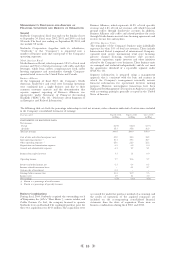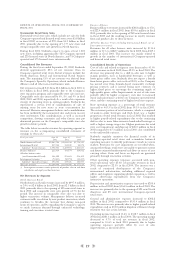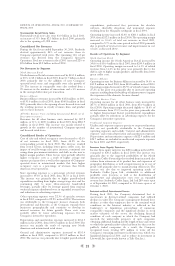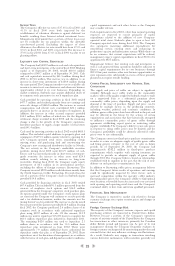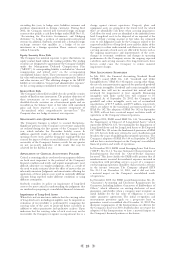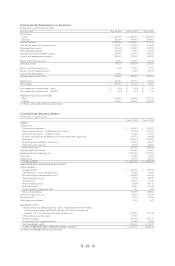Starbucks 2002 Annual Report Download - page 8
Download and view the complete annual report
Please find page 8 of the 2002 Starbucks annual report below. You can navigate through the pages in the report by either clicking on the pages listed below, or by using the keyword search tool below to find specific information within the annual report.
22
Income Taxes
The Company’s effective tax rates of 37.3% in fiscal 2001 and
41.1% in fiscal 2000 were both impacted by the
establishment of valuation allowances against deferred tax
benefits resulting from Internet-related investment losses.
Management determined that a portion of these losses may
not be realizable for tax purposes within the allowable
carryforward period. Excluding the impact of these
allowances, the effective tax rates would have been 37.0% and
37.6% in fiscal 2001 and 2000, respectively. The decrease to
37.0% in fiscal 2001 from 37.6% in fiscal 2000 was due to tax
planning efforts.
LIQUIDITY AND CAPITAL RESOURCES
The Company had $402.2 million in cash and cash equivalents
and short-term investments at the end of fiscal 2002.Working
capital as of September 29, 2002, totaled $310.0 million
compared to $148.7 million as of September 30, 2001. Cash
and cash equivalents increased by $61.3 million during fiscal
2002 to $174.6 million. This increase was in addition to an
increase in short-term investments of $120.4 million during
the same period.The Company intends to use its available cash
resources to invest in its core businesses and other new business
opportunities related to its core businesses. Depending on
market conditions, Starbucks may acquire additional shares of
its common stock pursuant to its stock repurchase plan.
Cash provided by operating activities in fiscal 2002 totaled
$477.7 million and resulted primarily from net earnings and
non-cash charges of $465.8 million. The increase in accrued
compensation and related costs contributed $24.1 million
primarily due to an increase in the number of employees. In
addition, the increase in other accrued expenses provided
$34.0 million, $18.0 million of which was for the litigation
settlement charge recorded in fiscal 2002, and the remaining
change is due to the growth of the Company’s operations.
Inventory purchases to supply a larger number of retail stores
used $41.4 million.
Cash used by investing activities in fiscal 2002 totaled $485.3
million.This included capital additions to property, plant and
equipment of $375.5 million mainly related to opening 614
new Company-operated retail stores, remodeling certain
existing stores, and purchasing land and constructing the
Company’s new roasting and distribution facility in Nevada.
The net activity in the Company’s marketable securities
portfolio during fiscal 2002 used $116.9 million of cash.
Excess cash was invested primarily in short-term, investment-
grade securities. An increase in other assets used $24.5
million, mainly relating to an increase in long-term
receivables. During fiscal 2002, the Company made equity
investments of $6.1 million in its international investees,
excluding the effects of foreign currency fluctuations. The
Company received $22.8 million in distributions mainly from
the North American Coffee Partnership. Proceeds from the
sale of a portion of the Company’s shares in Starbucks Japan
provided $14.8 million.
Cash provided by financing activities in fiscal 2002 totaled
$67.4 million.This included $91.3 million generated from the
exercise of employee stock options and $16.2 million
generated from the Company’s employee stock purchase plan.
As options granted under the Company’s stock option plans
are exercised, the Company will continue to receive proceeds
and a tax deduction; however, neither the amounts nor the
timing thereof can be predicted.The increase in checks issued
but not presented for payment provided $12.9 million. During
fiscal 2002, the Company purchased 2.6 million shares of its
common stock in accordance with authorized repurchase
plans using $52.2 million of cash. Of this amount, $10.2
million was used to repurchase 515,000 shares to complete the
$60.0 million repurchase plan initiated in September 2001.
The remaining $42.0 million was used to repurchase 2.1
million shares in accordance with the 10.0 million share
repurchase plan introduced in June 2002. There were
approximately 7.9 million additional shares authorized for
repurchase under this plan as of September 29, 2002. Share
repurchases are at the discretion of management, in accordance
with the terms of each plan, and depend on market conditions,
capital requirements and such other factors as the Company
may consider relevant.
Cash requirements in fiscal 2003, other than normal operating
expenses, are expected to consist primarily of capital
expenditures related to the addition of new Company-
operated retail stores. Starbucks plans to open at least 600
Company-operated stores during fiscal 2003. The Company
also anticipates incurring additional expenditures for
remodeling certain existing stores and enhancing its
production capacity and information systems.While there can
be no assurance that current expectations will be realized,
management expects capital expenditures in fiscal 2003 to be
approximately $425 million.
Management believes that existing cash and investments as
well as cash generated from operations should be sufficient to
finance capital requirements for its core businesses through
2003. New joint ventures, other new business opportunities or
store expansion rates substantially in excess of those presently
planned may require outside funding.
COFFEE PRICES,AVAILABILITY AND GENERAL RISK
CONDITIONS
The supply and price of coffee are subject to significant
volatility. Although most coffee trades in the commodity
market,coffee of the quality sought by Starbucks tends to trade
on a negotiated basis at a substantial premium above
commodity coffee prices, depending upon the supply and
demand at the time of purchase. Supply and price can be
affected by multiple factors in the producing countries,
including weather, political and economic conditions. In
addition, green coffee prices have been affected in the past, and
may be affected in the future, by the actions of certain
organizations and associations that have historically attempted
to influence commodity prices of green coffee through
agreements establishing export quotas or restricting coffee
supplies worldwide.The Company’s ability to raise sales prices
in response to rising coffee prices may be limited, and the
Company’s profitability could be adversely affected if coffee
prices were to rise substantially.
The Company enters into fixed-price purchase commitments
in order to secure an adequate supply of quality green coffee
and bring greater certainty to the cost of sales in future
periods. As of September 29, 2002, the Company had
approximately $242.2 million in fixed-price purchase
commitments which, together with existing inventory, are
expected to provide an adequate supply of green coffee
through 2003.The Company believes, based on relationships
established with its suppliers in the past, that the risk of non-
delivery on such purchase commitments is low.
In addition to fluctuating coffee prices, management believes
that the Company’s future results of operations and earnings
could be significantly impacted by other factors such as
increased competition within the specialty coffee industry,
fluctuating dairy prices, the Company’s ability to find optimal
store locations at favorable lease rates,increased costs associated
with opening and operating retail stores and the Company’s
continued ability to hire, train and retain qualified personnel.
FINANCIAL RISK MANAGEMENT
The Company is exposed to market risk related to foreign
currency exchange rates, equity security prices and changes in
interest rates.
Foreign Currency Exchange Risk
The majority of the Company’s revenue, expense and capital
purchasing activities are transacted in United States dollars.
However, because a portion of the Company’s operations
consists of activities outside of the United States, the Company
has transactions in other currencies, primarily the Canadian
dollar, British pound and Japanese yen. As part of its risk
management strategy, the Company frequently evaluates its
foreign currency exchange risk by monitoring market data and
external factors that may influence exchange rate fluctuations.
As a result, Starbucks may engage in transactions involving
various derivative instruments, with maturities generally not




